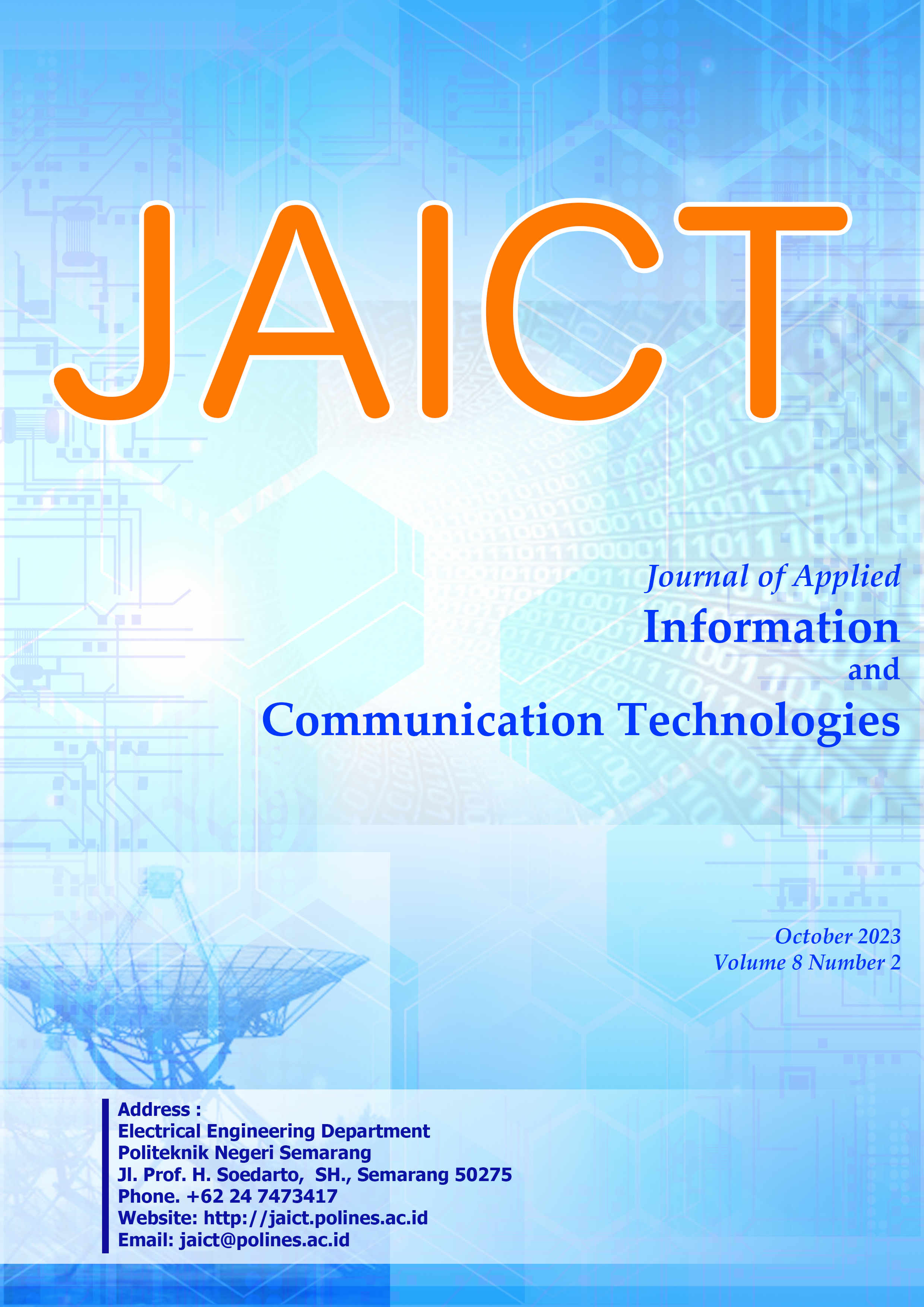Optimizing Call Setup Success (CSSR) Parameters In Mobile Communications Using K-Nearest Neighbor (K-NN)
DOI:
https://doi.org/10.32497/jaict.v8i2.5084Keywords:
Mobile Communication, CSSR, K-NN, OptimizationAbstract
The evaluation of the mobile communication network inside the cellular communication system, often known as the Global System for Mobile Communication, is crucial to achieve optimal call quality. The Call Setup Success Rate (CSSR) is a measure that plays a significant role in determining the performance of the mobile network, alongside various other factors. The mobile network's performance may decrease if the Call Setup Success Rate (CSSR) number is below the expected standard. The CSSR outcome is influenced by multiple variables that lack a specific formula or exhibit no discernible relationship with one another. The individual responsible for optimizing decisions in the real case is an operator or an engineer who relies on their experience to inform their choices. Nevertheless, even those with previous expertise in this domain may encounter difficulties determining the most effective approach for optimizing CSSR parameters since they must consider the interconnections among the many inherent values in these parameters. In order to achieve this objective, it is necessary to employ pattern recognition algorithms, among which the k-nearest Neighbor (k-NN) technique is included. In this study, the k-nearest Neighbor method will be employed to assist novice engineers in determining the optimization method for enhancing CSSR performance. Certain data from the OMC-R are utilized for the purpose of enhancing the performance of the CSSR and determining the feasibility of employing the k-NN pattern recognition approach to improve the CSSR. The efficacy of the k-Nearest Neighbors (k-NN) algorithm in providing an optimal solution, as determined by the operator or engineer on behalf of the telecommunication service provider, serves as a key indicator of the system's overall success. The implementation of CSSR optimization utilizing the k-NN algorithm decision has achieved a successful outcome, with 89.65% of the total data being accurately processed.References
M. P. Raj, P. R. Swaminarayan, J. R. Saini, and D. K. Parmar, ”˜Applications of Pattern Recognition Algorithms in Agriculture: A Review”™, Int. J. Advanced Networking and Applications, vol. 6, no. March, 2015.
B. N. Narayanan, O. Djaneye-Boundjou, and T. M. Kebede, ”˜Performance analysis of machine learning and pattern recognition algorithms for Malware classification”™, in Proceedings of the IEEE National Aerospace Electronics Conference, NAECON, 2016. doi: 10.1109/NAECON.2016.7856826.
M. Ortiz-Catalan, B. HÃ¥kansson, and R. BrÃ¥nemark, ”˜Real-time and simultaneous control of artificial limbs based on pattern recognition algorithms”™, IEEE Transactions on Neural Systems and Rehabilitation Engineering, vol. 22, no. 4, 2014, doi: 10.1109/TNSRE.2014.2305097.
Mujahidin I, Kitagawa A. Ring slot CP antenna for the hybrid electromagnetic solar energy harvesting and IoT application. Telkomnika (Telecommunication Computing Electronics and Control). 2023 Apr 1;21(2):290”“301..
Mujahidin, I.; Prasetya, D.A.; Nachrowie, S.A.S.; Arinda, P.S. Performance tuning of spade card antenna using mean average loss of backpropagation neural network. Int. J. Adv. Comput. Sci. Appl. 2020, 11, 639”“642.
H. Setio Jatmiko, I. Santoso, and A. A. Zahra, ”˜Aplikasi Jaringan Saraf Tiruan Sebagai Alat Bantu Analisis Optimalisasi Unjuk Kerja Call Setup Success Rate (CSSR) Pada Komunikasi GSM”™.
O. Oyetunji, ”˜Improving Call Setup Success Rate in GSM service area using RF optimisation”™, in Proceedings of the 11th International Conference on Electronics, Computer and Computation, ICECCO 2014, 2014. doi: 10.1109/ICECCO.2014.6997554.
B. Fatimah, ”˜Comparative analysis of traffic congestion of mobile communication networks in Osogbo, Nigeria”™, JEMT, vol. 6, 2018.
A. Galadima, D. Danjuma, and B. Buba, ”˜The Analysis Of Inter Cell Handover Dynamics in A GSM Network”™, International Journal of Innovative Research in Science, Engineering and Technology (An ISO, vol. 3297, 2014.
Roberts Omasheye Okiemute and Kolagbodi Eguriase Rowland, ”˜Performance Evaluation of Service Quality of MOBILE Network Provider in Lagos, South-west Nigeria”™.
T. Yuwono and F. Ferdiyanto, ”˜Measurement and analysis of 3G WCDMA network performance case study: Yogyakarta Indonesia”™, in Proceedings - 2015 4th International Conference on Instrumentation, Communications, Information Technology and Biomedical Engineering, ICICI-BME 2015, 2016. doi: 10.1109/ICICI-BME.2015.7401381.
G. C. Cardarilli, L. Di Nunzio, R. Fazzolari, A. Nannarelli, M. Re, and S. Spano, ”˜N-Dimensional Approximation of Euclidean Distance”™, IEEE Transactions on Circuits and Systems II: Express Briefs, vol. 67, no. 3, 2020, doi: 10.1109/TCSII.2019.2919545.
M. F. Naufal and Y. R. Wibisono, ”˜Finding The Most Desirable Car Using K-Nearest Neighbor From E-Commerce Websites”™, Jurnal ELTIKOM, vol. 5, no. 1, 2021, doi: 10.31961/eltikom.v5i1.221.
L. Zhang, Y. Zhang, J. Tang, K. Lu, and Q. Tian, ”˜Binary code ranking with weighted hamming distance”™, in Proceedings of the IEEE Computer Society Conference on Computer Vision and Pattern Recognition, 2013. doi: 10.1109/CVPR.2013.208.
F. N. Ma, S. Q. Jiang, J. T. Yang, and Q. Y. Ren, ”˜A binary space based on modified hamming distance for clustering”™, in IET Conference Publications, 2012. doi: 10.1049/cp.2012.0908.
L. Shboul, K. Fram, S. Sharaeh, M. Alshraideh, N. Shaar, and N. Alshraideh, ”˜Male and Female Hormone Reading to Predict Pregnancy Percentage Using a Deep Learning Technique: A Real Case Study”™, AI, vol. 3, no. 4, 2022, doi: 10.3390/ai3040053.
S. Anita and Albarda, ”˜Classification Cherry”™s Coffee using k-Nearest Neighbor (KNN) and Artificial Neural Network (ANN)”™, in 2020 International Conference on Information Technology Systems and Innovation, ICITSI 2020 - Proceedings, 2020. doi: 10.1109/ICITSI50517.2020.9264927.
Short Term Traffic Flow Prediction Using Machine Learning ”“ K-NN, Svm And Ann With Weather Information”™, International Journal For Traffic And Transport Engineering, vol. 10, no. 3, 2020, doi: 10.7708/ijtte.2020.10(3).08.
Downloads
Published
Issue
Section
License
Authors who publish with this journal agree to the following terms:Authors retain copyright and grant the journal right of first publication with the work simultaneously licensed under a Creative Commons Attribution License that allows others to share the work with an acknowledgement of the work's authorship and initial publication in this journal.
Authors are able to enter into separate, additional contractual arrangements for the non-exclusive distribution of the journal's published version of the work (e.g., post it to an institutional repository or publish it in a book), with an acknowledgement of its initial publication in this journal.
Authors are permitted and encouraged to post their work online (e.g., in institutional repositories or on their website) prior to and during the submission process, as it can lead to productive exchanges, as well as earlier and greater citation of published work (See The Effect of Open Access).






